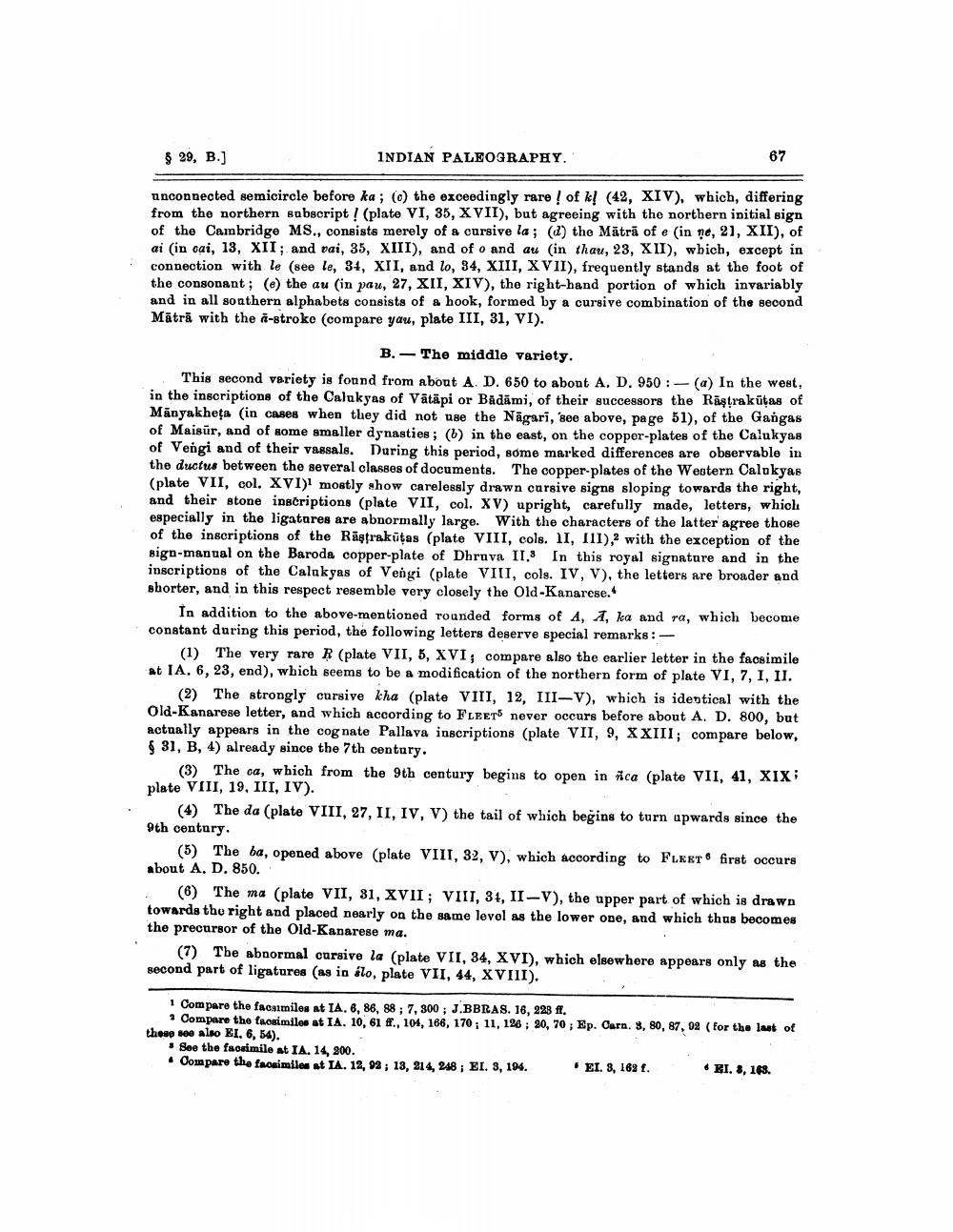________________
$ 29, B.]
INDIAN PALEOGRAPHY.
unconnected semicircle before ka ; (c) the exceedingly rare ! of k! (42, XIV), which, differing from the northern sabscript! (plate VI, 35, XVII), but agreeing with the northern initial sign of the Cambridge MS., consists merely of a cursive la; (d) the Mātrā of e (in ne, 21, XII), of ai (in oai, 13, XII; and vai, 35, XIII), and of o and au (in thau, 23, XII), which, except in connection with le (see le, 34, XII, and lo, 94, XIII, XVII), frequently stands at the foot of the consonant; (e) the au (in pau, 27, XII, XIV), the right-hand portion of which invariably and in all southern alphabets consists of a hook, formed by a cursive combination of the second Mātrā with the a-stroke (compare yau, plate III, 31, VI).
B. - The middle variety. This second variety is found from about A. D. 650 to abont A. D. 950 :- (a) In the west, in the inscriptions of the Calukyas of Vātapi or Badāmi, of their successors the Rāşırakūtas of Mänyakheta (in cases when they did not use the Nägari, see above, page 51), of the Gangas of Maisūr, and of some smaller dynasties; (6) in the east, on the copper-plates of the Calukyas of Vengi and of their vassals. During this period, some marked differences are observable in the ductus between the several classes of documents. The copper-plates of the Western Calokyas (plate VII, col. XVI) mostly show carelessly drawn cursive signs sloping towards the right, and their stone inscriptions (plate VII, col. XV) upright, carefully made, letters, which especially in the ligatures are abnormally large. With the characters of the latter agree those of the inscriptions of the Rāştrakūtas (plate VIII, cols. II, III), with the exception of the sign-manual on the Baroda copper-plate of Dhruva II. In this royal signature and in the inscriptions of the Calakyas of Vengi (plate VIII, cols. IV, V), the letters are broader and shorter, and in this respect resemble very closely the Old-Kanarese.
In addition to the above-mentioned rounded forms of 4, A, ka and ra, which become constant during this period, the following letters deserve special remarks: -
(1) The very rare R (plate VII, 5, XVI, compare also the earlier letter in the facsimile at IA. 6, 23, end), which seems to be a modification of the northern form of plate VI, 7, I, II.
(2) The strongly cursive kha (plate VIII, 12, III-V), which is identical with the Old-Kanarese letter, and which according to FLEETS never occurs before about A. D. 800, but actually appears in the cognate Pallava inscriptions (plate VII, 9, XXIII; compare below, 31, B, 4) already since the 7th century.
(3) The ca, which from the 9th century begins to open in ñca (plate VII, 41, XIX: plate VIII, 19, III, IV).
(4) The da (plate VIII, 27, II, IV, V) the tail of which begins to turn upwards since the 9th century.
(5) The ba, opened above (plate VIII, 32, v), which according to FLEET first occurs about A. D. 850.
(6) The ma (plate VII, 81, XVII; VIIT, 31, II-V), the upper part of which is drawn towards the right and placed nearly on the same level as the lower one, and which thus becomes the precursor of the Old-Kanarese ma.
(7) The abnormal cursive la (plate VII, 34, XVI), which elsewhere appears only as the second part of ligatures (as in élo, plate VII, 44, XVIII).
1 Compare the facsimiles at IA. 6, 86, 88 ; 7, 300 ; J.BBRAS. 16, 223 ff.
Compare the facsimilos at IA. 10, 61 ff., 104, 166, 170, 11, 126 ; 20, 70; Ep. Carn. 8, 80, 87, 02 (for the last of those see also EI, 6, 54).
• See the facsimile at IA. 14, 900. • Compare the facsimiles at IA. 12, 92; 13, 214, 248, EL. 3, 194. EI. 3, 162 f. EI. 8, 168.




